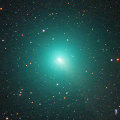
|
It approached to the earth down to 0.12 A.U. and brightened up to 4.6 mag in October (Oct. 18, Juan Jose Gonzalez). It was very large, double of the full moon, and very bright, visible with naked eyes. Now it is fading, but still bright as 11.0 mag (Feb. 5, Juan Jose Gonzalez). After this, it keeps observable for a long time until June when it fades down to 17 mag.
Date(TT) R.A. (2000) Decl. Delta r Elong. m1 Best Time(A, h)
Feb. 5 7 4.60 -7 27.6 0.786 1.669 140 11.7 22:03 (180, 62)
Feb. 12 7 6.47 -5 28.7 0.873 1.732 137 12.2 21:38 (180, 60)
|
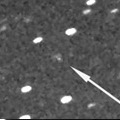
|
Now it is 12.9 mag (Dec. 27, Ken-ichi Kadota). Bright, but it locates extremely low. It will be fading after this. The condition in this apparition is bad. It will be getting higher gradually after this in the Southern Hemisphere, however, it keeps extremely low until May in the Northern Hemisphere.
Date(TT) R.A. (2000) Decl. Delta r Elong. m1 Best Time(A, h)
Feb. 5 18 58.11 -24 30.8 2.265 1.529 32 12.4 3:48 (292, 12)
Feb. 12 19 21.42 -24 26.2 2.252 1.541 34 12.5 3:57 (290, 14)
|

|
Already very bright, much brighter than expected, as 10.5 mag (Jan. 3, Alexandre Amorim). Not observable now. It is expected to keep so bright as 6-8 mag for a long time from 2011 to 2012, and to be observable in good condition in the Northern Hemisphere. It will appear in the morning sky in late March in the Southern Hemisphere, or in late April in the Northern Hemisphere.
Date(TT) R.A. (2000) Decl. Delta r Elong. m1 Best Time(A, h)
Feb. 5 22 13.73 -22 41.3 5.104 4.164 15 12.9 20:38 ( 59, -3)
Feb. 12 22 17.46 -21 40.6 5.060 4.098 11 12.8 20:29 ( 58, -6)
|

|
Big asteroid discovered in 1906. It suddenly showed the cometary activity on Dec. 11, probably due to an impact of a small object. It was very bright as 11.5 mag visually (Dec. 17, Juan Jose Gonzalez). It had a dust coma still on Jan. 9 (Joseph Brimacombe). Now it is stellar at 13.6 mag (Feb. 5, Juan Jose Gonzalez).
Date(TT) R.A. (2000) Decl. Delta r Elong. m1 Best Time(A, h)
Feb. 5 9 36.46 34 56.2 2.077 3.025 160 13.4 0:39 (180, 20)
Feb. 12 9 29.71 35 36.0 2.075 3.014 158 13.4 0:05 (180, 19)
|

|
Now it is 13.5 mag (Jan. 24, Juan Jose Gonzalez).
Date(TT) R.A. (2000) Decl. Delta r Elong. m1 Best Time(A, h)
Feb. 5 11 11.14 -0 57.5 5.405 6.247 146 13.6 2:13 (180, 56)
Feb. 12 11 8.62 -0 50.0 5.348 6.248 153 13.6 1:43 (180, 56)
|
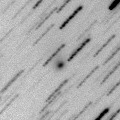
|
Now it is 13.3 mag, much brighter than originally expected and visible visually (Jan. 24, Juan Jose Gonzalez). In the Southern Hemisphere, it will be unobservable until spring. In the Northern Hemisphere, the altitude will be lower than 10 degree from February to April.
Date(TT) R.A. (2000) Decl. Delta r Elong. m1 Best Time(A, h)
Feb. 5 22 1.98 27 3.1 3.123 2.522 44 14.2 20:38 (101,-34)
Feb. 12 22 12.54 25 33.3 3.197 2.525 40 14.3 20:29 ( 99,-35)
|
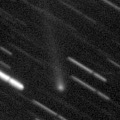
|
Now it is 13.5 mag and visible visually (Feb. 4, Juan Jose Gonzalez). It has a long tail by CCD observations. It keeps observable at 14-15 mag in good condition until spring.
Date(TT) R.A. (2000) Decl. Delta r Elong. m1 Best Time(A, h)
Feb. 5 4 51.99 -14 31.9 2.473 2.942 108 14.7 20:38 (149, 67)
Feb. 12 4 44.73 -15 14.5 2.585 2.942 101 14.8 20:29 (135, 64)
|
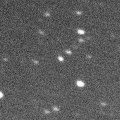
|
Now it is 14.7 mag (Dec. 27, D. Chestnov and A. Novichonok). It keeps bright as 14-15 mag for a long time after this until 2013. It is not observable in the Northern Hemisphere, but it is observable in good condition in the Southern Hemisphere.
Date(TT) R.A. (2000) Decl. Delta r Elong. m1 Best Time(A, h)
Feb. 5 16 22.50 -64 56.8 6.263 5.965 68 14.7 3:48 (330, 46)
Feb. 12 16 27.50 -66 19.7 6.165 5.944 72 14.7 3:57 (334, 49)
|

|
A small outburst occured and it brightened by 2 mag, up to 16.1 mag, on 2010 Aug. 31 (Bernhard Haeusler). Now it is 15.5 mag (Jan. 27, Catalina Sky Survey). It will brighten up to 11.5 mag in autumn. In the Northern Hemisphere, it keeps observable for a long time until 2012 spring. In the Southern Hemisphere, it is not observable until November.
Date(TT) R.A. (2000) Decl. Delta r Elong. m1 Best Time(A, h)
Feb. 5 17 20.65 33 14.3 3.238 3.116 74 15.0 3:48 (231, -4)
Feb. 12 17 28.91 35 57.8 3.117 3.059 77 14.8 3:57 (225, -1)
|

|
It is already bright as 14.5 mag and visible visually (Sept. 30, Alan Hale). Now it is unobservable. But it will appear in the morning sky in late February in the Northern Hemisphere, or in late March in the Southern Hemisphere. It will be observable at 13-14 mag for a long time from 2011 to 2012.
Date(TT) R.A. (2000) Decl. Delta r Elong. m1 Best Time(A, h)
Feb. 5 20 22.61 -7 1.8 7.029 6.083 15 15.1 3:48 (290,-15)
Feb. 12 20 24.39 -6 53.3 6.975 6.056 19 15.1 3:57 (285, -8)
|

|
It reached up to 7.7 mag in 2009 summer (2009 Aug. 13, Chris Wyatt). Now it is fading, but still bright as 13.7 mag (Feb. 7, A. Novichonok, D. Chestnov). It will never be observable again in the Northern Hemisphere. In the Southern Hemisphere, it keeps observable in good condition until 2011 autumn when it becomes fainter than 18 mag.
Date(TT) R.A. (2000) Decl. Delta r Elong. m1 Best Time(A, h)
Feb. 5 18 16.24 -52 22.5 6.648 6.063 50 15.3 3:48 (315, 31)
Feb. 12 18 19.10 -53 4.3 6.614 6.111 55 15.4 3:57 (314, 36)
|
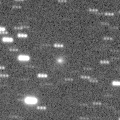
|
Now it is 15.3 mag (Dec. 27, D. Chestnov and A. Novichonok), much brighter than originally expected. It keeps 16 mag until 2011 spring. It keeps observable in good condition in the Southern Hemisphere. But in the Northern Hemisphere, it locates very low in 2011 spring only.
Date(TT) R.A. (2000) Decl. Delta r Elong. m1 Best Time(A, h)
Feb. 5 6 23.40 -59 7.5 2.694 2.984 97 15.6 21:21 ( 0, 66)
Feb. 12 6 8.31 -55 14.4 2.709 3.006 97 15.7 20:38 ( 0, 70)
|
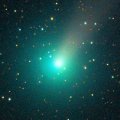
|
It brightened up to 7.9 mag in April and May (May 5, Juan Jose Gonzalez). Now it is fading. The central part is so faint as 16-17 mag. However, extremely faint large coma extends, and the total brightness is still bright as 14.3 mag (Dec. 27, D. Chestnov and A. Novichonok). It keeps observable for a long time until when it fades out in the Northern Hemisphere. It is not observable in the Southern Hemisphere.
Date(TT) R.A. (2000) Decl. Delta r Elong. m1 Best Time(A, h)
Feb. 5 4 7.45 31 18.8 3.354 3.803 109 15.7 20:38 (159, 20)
Feb. 12 4 6.31 30 2.6 3.538 3.872 102 15.9 20:29 (154, 20)
|

|
Now it is 15.2 mag (Nov. 27, A. Novichonok and D. Chestnov). It will be fading very slowly after this. In the Northern Hemisphere, it temporarily becomes low in January, but it keeps observable for a long time until 2012 spring when it fades down to 17-18 mag. It will not be observable in the Southern Hemisphere.
Date(TT) R.A. (2000) Decl. Delta r Elong. m1 Best Time(A, h)
Feb. 5 20 30.52 33 51.5 5.186 4.629 50 15.7 3:48 (252,-38)
Feb. 12 20 40.75 34 26.1 5.209 4.642 50 15.8 3:57 (248,-33)
|

|
Now it is 16.3 mag (Feb. 4, Tzec Maun Observatory). It has a long tail by CCD observations. It keeps observable after this while fading gradually.
Date(TT) R.A. (2000) Decl. Delta r Elong. m1 Best Time(A, h)
Feb. 5 13 22.25 -27 28.8 2.102 2.548 105 16.0 3:48 (229, 79)
Feb. 12 13 22.10 -27 57.8 2.059 2.595 111 16.1 3:56 (180, 83)
|
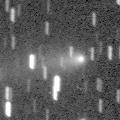
|
It reached up to 14.0 mag and became visible visually in December (Dec. 17, Juan Jose Gonzalez). It keeps locating high in the Northern Hemisphere after this. But it will be fading. It has already faded down to 15.9 mag (Jan. 29, E. Bryssinck). It will be fainter than 18 mag in April. It locates low in the Southern Hemisphere.
Date(TT) R.A. (2000) Decl. Delta r Elong. m1 Best Time(A, h)
Feb. 5 6 7.13 44 16.0 1.554 2.331 131 16.1 21:06 (180, 11)
Feb. 12 6 7.65 44 25.9 1.637 2.353 125 16.3 20:39 (180, 11)
|

|
It has kept bright as 8.5 mag since July until September. Now it is fading, but it is still bright as 14.5 mag (Jan. 24, Tzec Maun Observatory).
Date(TT) R.A. (2000) Decl. Delta r Elong. m1 Best Time(A, h)
Feb. 5 2 14.27 2 18.4 2.481 2.450 76 16.2 20:38 (117, 29)
Feb. 12 2 23.37 3 38.5 2.608 2.492 72 16.4 20:29 (116, 27)
|
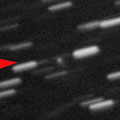
|
Now it is 15.7 mag (Jan. 23, Toru Yusa). In the Northern Hemisphere, it keeps observable in good condition until 2011 spring when it brightens up to 16 mag. In the Southern Hemisphere, it keeps locating low.
Date(TT) R.A. (2000) Decl. Delta r Elong. m1 Best Time(A, h)
Feb. 5 4 45.05 38 27.6 1.795 2.419 117 16.4 20:38 (169, 15)
Feb. 12 4 47.70 38 21.8 1.848 2.395 111 16.4 20:29 (166, 15)
|

|
It had been bright as 13-14 mag for a long time from 2007 to 2009. Now it is fading, but it is 15.3 mag still now (Dec. 10, D. Chestnov and A. Novichonok), much brighter than predicted. It keeps observable at 16 mag in good condition until spring.
Date(TT) R.A. (2000) Decl. Delta r Elong. m1 Best Time(A, h)
Feb. 5 11 38.19 40 31.8 8.698 9.476 140 16.7 2:40 (180, 15)
Feb. 12 11 33.45 41 1.4 8.701 9.511 143 16.7 2:08 (180, 14)
|

|
It was observed only during 3 days in 2009 May, then it has been lost. The ephemeris says that it passes the perihelion in 2011 January and it will be observable at 17 mag. But actually, it will not be found.
Date(TT) R.A. (2000) Decl. Delta r Elong. m1 Best Time(A, h)
Feb. 5 6 16.66 -16 32.8 3.250 3.908 125 17.0 21:15 (180, 71)
Feb. 12 6 4.48 -15 31.5 3.337 3.913 119 17.0 20:35 (180, 70)
|

|
Now it is 17.9 mag (Jan. 17, Ken-ichi Kadota). It keeps 15 mag from 2011 summer to 2012 summer. But it is not observable around the perihelion. It is observable in good condition in the Northern Hemisphere in 2011, and in the Southern Hemisphere in 2012.
Date(TT) R.A. (2000) Decl. Delta r Elong. m1 Best Time(A, h)
Feb. 5 13 37.63 17 59.9 3.502 4.045 116 17.3 3:48 (195, 36)
Feb. 12 13 39.70 18 49.9 3.370 3.990 122 17.1 3:57 (185, 36)
|

|
It was observed around 16 mag in 2009 and 2010. In 2011, it keeps observable at 17 mag from spring to autumn. It locates somewhat low in the Northern Hemisphere.
Date(TT) R.A. (2000) Decl. Delta r Elong. m1 Best Time(A, h)
Feb. 5 17 4.19 -21 32.0 4.408 3.985 58 17.2 3:48 (275, 33)
Feb. 12 17 10.73 -21 44.1 4.323 3.994 64 17.2 3:57 (271, 39)
|

|
Now it is 16.3 mag (Feb. 3, E. Bryssinck), brighter than this ephemeris. It is expected to be 15 mag and will be observable in good condition in 2013. It is observable in good condition in the Northern Hemisphere, but not observable in the Southern Hemisphere now.
Date(TT) R.A. (2000) Decl. Delta r Elong. m1 Best Time(A, h)
Feb. 5 1 30.71 55 23.6 8.165 8.219 89 17.2 20:38 (149,-15)
Feb. 12 1 30.39 54 56.2 8.230 8.188 84 17.2 20:29 (147,-17)
|

|
Large Centaur-type asteroid. Now it is 17.0 mag (Jan. 7, Tzec Maun Observatory). It keeps observable at 17-18 mag for a long time until 2013.
Date(TT) R.A. (2000) Decl. Delta r Elong. m1 Best Time(A, h)
Feb. 5 7 34.91 -13 43.5 5.685 6.487 141 17.3 22:33 (180, 69)
Feb. 12 7 30.30 -12 41.8 5.718 6.487 138 17.3 22:01 (180, 68)
|

|
Now it is 17.5 mag (Jan. 26, C. Rinner, F. Kugel). It tends to be brightest after the perihelion passage. At the discovery in 1999, it became brightest one year after the perihelion passage. At this time, it became brightest three months after the perihelion passage, then it is fading. It keeps observable in good condition at 18 mag until may.
Date(TT) R.A. (2000) Decl. Delta r Elong. m1 Best Time(A, h)
Feb. 5 10 23.80 7 17.7 2.747 3.691 160 17.3 1:26 (180, 48)
Feb. 12 10 19.58 7 37.0 2.736 3.708 168 17.3 0:54 (180, 47)
|

|
Now it is 16.9 mag (Feb. 2, J. M. Bosch). It is observable in good condition in the Northern Hemisphere. It must have been bright as 16 mag since September, but it was not discovered. It will be fading after this, and will be fainter than 18 mag in February. It locates low in the Southern Hemisphere.
Date(TT) R.A. (2000) Decl. Delta r Elong. m1 Best Time(A, h)
Feb. 5 5 20.74 40 48.4 1.378 2.101 124 17.4 20:38 (176, 14)
Feb. 12 5 28.75 39 58.9 1.473 2.140 119 17.6 20:29 (174, 15)
|

|
Asteroid discovered in 2002 was revealed to be a comet. Now it is 17.1 mag (Feb. 4, Tzec Maun Observatory). It will be fading after this, and will be fainter than 18 mag in February. It is observable in good condition in the Northern Hemisphere. It is not observable in the Southern Hemisphere.
Date(TT) R.A. (2000) Decl. Delta r Elong. m1 Best Time(A, h)
Feb. 5 6 56.80 53 25.9 0.665 1.526 134 17.4 21:57 (180, 2)
Feb. 12 7 8.03 52 29.4 0.707 1.546 130 17.6 21:40 (180, 3)
|
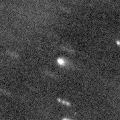
|
It will approach to the sun down to 0.5 A.U. in September, and it is expected to brighten up to 6 mag. Now it is 17.9 mag (Feb. 4, Tzec Maun Observatory). It will be brightening gradually. In the Southern Hemisphere, it keeps observable until early September when it becomes 7 mag. In the Northern Hemisphere, it becomes unobservable in August. But after appearing in the morning sky in October, it becomes observable in the excellent condition at midnight.
Date(TT) R.A. (2000) Decl. Delta r Elong. m1 Best Time(A, h)
Feb. 5 12 4.54 -1 38.8 2.807 3.563 133 17.8 3:06 (180, 57)
Feb. 12 12 1.29 -1 21.4 2.648 3.479 141 17.5 2:36 (180, 56)
|
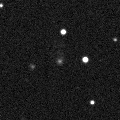
|
Now it is 17.2 mag (Feb. 4, Tzec Maun Observatory). It is fading slowly. In the Northern Hemisphere, it keeps observable in good condition until 2011 summer. It is not observable in the Southern Hemisphere.
Date(TT) R.A. (2000) Decl. Delta r Elong. m1 Best Time(A, h)
Feb. 5 17 34.73 43 21.7 5.445 5.321 77 17.5 3:48 (225,-12)
Feb. 12 17 37.08 43 39.0 5.428 5.343 79 17.5 3:57 (221, -8)
|
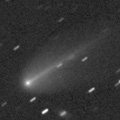
|
Bright new comet discovered visually by Kaoru Ikeya and Shigeki Murakami. It was so bright as 7.6 mag at that time (Nov. 4, Juan Jose Gonzalez). Now it is 14.8 mag (Jan. 7, Ken-ichi Kadota). Its envelope similar to 17P/Holmes is getting diffuse rapidly. The central nucleus has faded down to 17.9 mag (Jan. 14, Leonid Elenin). In the Northern Hemisphere, it keeps observable for a long time after this in the morning low sky. It locates very low in the Southern Hemisphere, but it will be getting higher gradually.
Date(TT) R.A. (2000) Decl. Delta r Elong. m1 Best Time(A, h)
Feb. 5 16 13.25 -26 8.5 2.003 1.899 69 17.6 3:48 (273, 45)
Feb. 12 16 26.45 -27 13.2 1.964 1.933 73 18.1 3:57 (272, 50)
|

|
Now it is 17.8 mag (Jan. 27, Tzec Maun Observatory). It was observed at 18 mag in winter between 2009 and 2010. It will be observable again at 18 mag in good condition from winter to spring in 2011.
Date(TT) R.A. (2000) Decl. Delta r Elong. m1 Best Time(A, h)
Feb. 5 10 54.43 11 14.4 2.546 3.464 154 17.8 1:57 (180, 44)
Feb. 12 10 50.88 11 45.9 2.513 3.468 162 17.8 1:26 (180, 43)
|
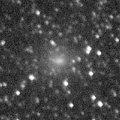
|
It had been predicted so faint as 19 mag. But actually it was observed much brighter than expected, 16.6 mag on Dec. 7 (Catalina Sky Survey), and 15.7 mag on Dec. 31 (Francois Kugel). Maybe it was in outburst. However, it has already faded down to 18.2 mag (Jan. 26, Tzec Maun Observatory).
Date(TT) R.A. (2000) Decl. Delta r Elong. m1 Best Time(A, h)
Feb. 5 3 55.55 21 58.4 3.476 3.861 105 19.6 20:38 (153, 28)
Feb. 12 3 57.15 22 3.3 3.611 3.889 98 19.7 20:29 (149, 26)
|
|
![]()
 C/2011 A3 ( Gibbs )
C/2011 A3 ( Gibbs ) 74P/Smirnova-Chernykh
74P/Smirnova-Chernykh C/2010 S1 ( LINEAR )
C/2010 S1 ( LINEAR ) 2008 YB3
2008 YB3 203P/2008 R4 ( Korlevic )
203P/2008 R4 ( Korlevic ) P/2010 WK ( LINEAR )
P/2010 WK ( LINEAR ) 247P/2010 V3 ( LINEAR )
247P/2010 V3 ( LINEAR ) C/2010 X1 ( Elenin )
C/2010 X1 ( Elenin ) C/2007 VO53 ( Spacewatch )
C/2007 VO53 ( Spacewatch ) P/2010 V1 ( Ikeya-Murakami )
P/2010 V1 ( Ikeya-Murakami ) 31P/Schwassmann-Wachmann 2
31P/Schwassmann-Wachmann 2 88P/Howell
88P/Howell![]()


























